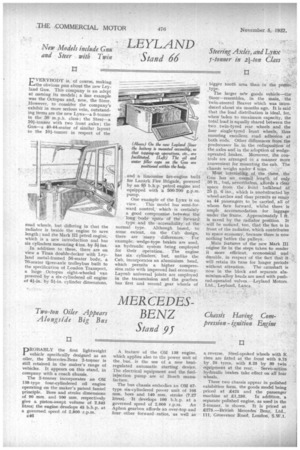LEYLAND
Page 54

If you've noticed an error in this article please click here to report it so we can fix it.
Stand 66
La VERYBODY is, of corn-se, making
the obvious pun about the new Leyland Gnu. This company is an adept at naming its models; a fine example was the Octopus and, now, the Steer. However, to consider the company's exhibit in more serious vein, outstanding items are the new Lynx—a 5-tonner in the 30 m.p.h. class ; the Steer—a liq--tonner with two front axles ; the Gnu—a 40-44-seater of similar layout to the 10k-tonner in respect of the road wheels, but differing in that the radiator is beside the engine to save length ; and the Mark III petrol engine, which is a new introduction and has six cylinders measuring 4ins. by 5i ins.
In addition to • these, there are on view a Titan double-decker with Leyland metal-framed 56-seater body, a 70-seater tree-axle troneybus built to the specification of London Transport, a large Octopus eight-wheeled van powered by a six-cylindered oil engine of 4i-in. by 5i-in, cylinder dimensions,
and a limousine fire-engine built for Lanark Fire Brigade, powered by an 85 b.h.p. petrol engine and equipped with a 500-700 g.p.m. pump.
One exaMple of the Lynx is on
view. This 'model has semi-forward control, which is certainly a good compromise betwe'en the long body space of the forward type and the accessibility" of the normal type. Although based, to some extent, on the Cub design, there are many differences. For example, wedge-type brakes are used, an hydraulic system being employed for their operation. The engine has six cylinders, but, unlike the Cub, incorporates an aluminium head, which permits a higher compression ratio with improved fuel economy: Layrub universal joints are employed in the transmission and the gearbox has first and second gear Wheels of
bigger tooth area than in the prdto ,type.
The larger new goods vehicle—the Steer—resembles, in the main, the twin-steered Beaver which was introduced about six months ago. It is said that the load distribution is ideal, for, when laden to maximum capacity, the total load is equally shared between the two twin-tyred rear wheels and the four single-tyred 'front wheels, thus ensuring excellent road adhesion at both ends. Other differences from the predecessor lie in the redisposition of the axles and in the adoption of wedgeoperated brakes. Moreover, the controls are arranged in a manner more convenient for mounting the cab. The chassis weighs under 4 tons. Most intereaag of the three the Gnu has an overall length of only 30 ft., laut, nevertheless, affords a clear space from the. fron_t bulkhead of 25 ft. 6 ins., which is unobstructed by wheel-arches and thus permits as many. as 44 passengers to be carried, all of whom face forward, whilst there is ample accommodation for luggage under the frame. Approximately 1 ft. is saved by the radiator position. It will be noticed, too, that the fan is in front of the radiator, which contributes to space econom3i, because there is now nothing beffire the pulleys.
Main features of the new Mark III engine lie in the steps taken to render it more efficient, economical and durable, in respect of the fact that it will retain its tune for longer periods
without attention. The camshaft is now in the block and separate aluminium-alloy heads are used with pushrod-operated valves.--Leyland Motors, Ltd., Leyland, Lancs.


















































































